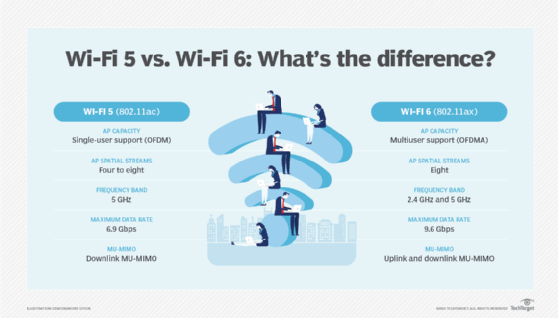Myths and realities of a Wi-Fi 6 upgrade
Despite the promise of high data rates, longer client battery life and more efficient radio techniques, enterprises need to weigh Wi-Fi 6's limitations.
Getting fired up about Wi-Fi 6 is understandable. The promise of fast-as-wire speeds; new radio magic like orthogonal frequency division multiple access; multi-user, multiple-input, multiple-output technology; traveling-wave tube; and new Wi-Fi Protected Access 3 security are compelling Wi-Fi 6 benefits.
But when it comes to wireless, nuance rules, and every situation is an "if this, then that" paradigm. It's important to tap the brakes and understand why the IEEE 802.11ax standard may never truly deliver all that's being touted about it.
Wireless standards tend to underdeliver
The sixth generation of Wi-Fi spawned by the IEEE 802.11 working group, 802.11ax will absolutely be the highest performing wireless LAN (WLAN) technology yet. But will we recognize speeds that approach 10 Gbps as promised by the standard? Will we be able to use every optional whizzbang feature specified by the standard for every WLAN environment? The answer to both questions is an unequivocal "no" -- regardless of what the WLAN vendor marketing departments may want us to believe.
Wi-Fi is still a shared half-duplex medium. Despite some imaginative marketing claims, using 802.11ax doesn't provide a "wireless switch." Even where multiple streams and resource units can be used to service multiple client devices at the same time, the access point listens while the client transmits -- and vice versa. Half-duplex is one of those persistent characteristics that prevents WLAN speeds from ever reaching their data rates. Switches use collision detection mechanisms, whereas Wi-Fi can only hope to avoid collisions when ensuring that one device at a time transmits. These underpinnings go all the way back to the original 802.11 standard.
Backward compatibility is a double-edged sword. Wireless administrators have some influence over backward compatibility. 802.11ax promises compatibility all the way back to 802.11b for older client devices, but enabling that compatibility slows the overall performance of the cell serving the older client. Wireless engineers have been disabling the slowest rates for years to preserve cell performance and control the effective size of a given coverage area. Many of us wish the IEEE would have already drawn a reasonable line against backward compatibility. Otherwise, offending client device makers have no reason to modernize their decades-old equipment.
Confusion abounds. Starting with 802.11n, vendors have been rushing their early latest-technology access points to market and calling the initial volley Wave 1. The "wave" tag is not defined by the wireless standard; rather it's a gimmick vendors use to claim that they're shipping the latest technology, even if it comes with fewer radio chain counts and other reduced hardware resources. When considering Wi-Fi 6, be mindful of early Wave 1 versus more robust and better equipped Wave 2 access points.
Wide channels are often unrealistic. According to any data rate chart for wireless standards, the highest rates come with the widest channels. In many cases, that's the stuff of marketing hype. Most enterprise WLAN designers will use 20- or 40-MHz-wide channels and won't enable 80 or 160 MHz. Wider channels reduce the overall channel counts available, which doesn't play well in dense environments. Simply put, the biggest data rate numbers stated in a wireless standard, including Wi-Fi 6, are generally unattainable in the real world.

Client space is fragmented. A new WLAN standard isn't a cure-all for decades of dysfunction in the client device space. Client devices are all over the place when it comes to hardware capability and driver stability. Any Wi-Fi 6 WLAN will likely support a majority of legacy client devices -- such as a mix of 802.11g, n, ac and early ax -- for at least the next two years. All these devices should benefit from a connection to a Wi-Fi 6 WLAN, but it can be hard to say whether the cost of upgrading will be justified, depending on the client mix. There are also early deployments from major vendors where Wi-Fi 6 features need to be wholesale disabled or else the WLAN is unusable by today's clients.
New cost models can be hard to swallow. WLAN vendors are continuously recasting themselves and retooling how they price their products to increase their revenue. Market leader Cisco, for example, now touts itself as a software company. But Cisco customers who haven't purchased new WLAN gear for several years might find there's plenty not to like when shopping for Wi-Fi 6. Licensing paradigms are getting ever more confusing, and customers might feel like they're expected to rent what they've already purchased. Cisco isn't the only vendor that has customers scratching their heads. Time will tell whether these new licensing schemes will translate into better code quality under the hood.
Wi-Fi 6 is impressive, but manage the expectations
Potentially high data rates, more efficient modulation and radio techniques, and the promise of better client battery life are all good reasons to consider upgrading to 802.11ax when a refresh is due. At the same time, be aware of the realities that can dull some of the Wi-Fi 6 marketing luster.
We will likely always need Wi-Fi, but perhaps not as much as we once did as other technologies take hold. With 5G, the Citizens Broadband Radio Service frequency band and IoT-specific technologies like long-range WAN all gaining traction in parallel with Wi-Fi 6, wireless network designers are realizing that Wi-Fi has limitations.
Since the COVID-19 pandemic has put a hit on customers' IT budgets, it's imperative that the best technology be applied to a given application and not to force every application through the Wi-Fi funnel. For applications ranging from building controls to industrial settings, there are new options beyond Wi-Fi to consider.






